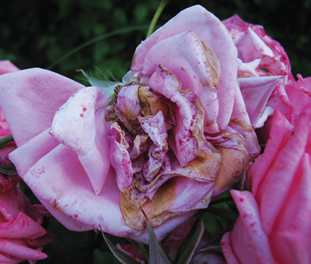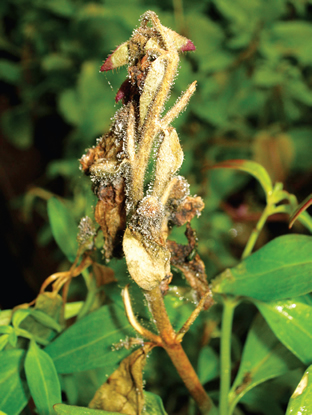Introduction Botrytis is one of the most damaging pathogens with stems, leaves, flowers, fruit and seedlings all being potential victims. Many growers are familiar with the symptoms of Botrytis, but for some, the first encounter with this pathogen results in severe plants losses therefore early detection and control are vital if the disease is to be prevented from rapidly spreading though a crop.
Botrytis is one of the most damaging pathogens with stems, leaves, flowers, fruit and seedlings all being potential victims. Many growers are familiar with the symptoms of Botrytis, but for some, the first encounter with this pathogen results in severe plants losses therefore early detection and control are vital if the disease is to be prevented from rapidly spreading though a crop.
While Botrytis is a formidable pathogen, it is also the same fungi which is employed by some wine makers and was even given the name ‘The Nobel rot’ for its ability to concentrate sugars and impart a particular flavor to late harvest grapes. Wine makers in many areas of the world make use of Botrytis infection of their grapes to produce a sweet, high quality wine, which commands high prices. Despite this beneficial use of Botrytis, it is a disease, which plagues commercial and hobbyist growers alike, and one that affects virtually all of the crops we grow hydroponically.
Botrytis symptoms
Plants can be attacked at any stage of growth, from tiny seedlings to large, mature plants, but new succulent growth, freshly injured tissues and ageing or dead foliage are favored by this disease. Botrytis usually first appears as lesions on leaves and stems which quickly produce a characteristic grey/brown furry spore development which resembles a pile of ash – hence the name ‘grey or ash mould’. As the disease progresses the lesions continue to grow and encircle stems and leaf petioles and will eventually cause plant collapse. Fungal spores can also develop on flower petals, particularly under growing conditions where condensation has been forming and humidity levels are high.
Infection of flower petals leads to rapid disease development in young fruit with the fruit tissue rapidly disintegrating into a water soaked mass. Green fruits that are infected with airborne Botrytis spores, rather than via infected leaf tissue, don’t rot and decay, but they often develop a condition called ‘Ghost spot’ which results in pale, cream colored rings on the surface of the fruit.
Post harvest rots can often be attributed to Botrytis infection as well, especially when increased humidity in storage promotes the germinating of spores present on the surface of the cut foliage. These rots appear as large water soaked areas often covered with grey mould termed ‘conidiophores’.
Fungal life cycle
Botrytis is commonly a disease associated with humid conditions, which are required for successful spore germination and temperatures around 150C- 230C, although it can thrive in cooler conditions. Crops grown towards late winter and early spring are most susceptible to disease although it can be prevalent throughout the year in grow rooms. Spores germinate faster as the relative humidity approaches 100% and germination is most rapid where free water is present on the plant foliage such as that produced by condensation.
Once spores germinate on the plant they enter the host tissue and form mycelium, which invades the intercellular spaces within the plant tissue. This mycelium then forms conidiophores, which emerge through the infected tissue and release conidia into the air. If infected stems and foliage are not removed from the growing area, they become a source of conidia, which develop on lesions and rapidly infect healthy crops when conditions are suitable. High temperature and dry conditions eliminate the survival spores from one crop to the next.
Spores are released from infected crops when the crop is disturbed as in pruning or harvesting and these spores readily infect more plants through open cuts on the stems. Spores are not only produced in large numbers on lesions on the plant, but also on plant debris left in the growing area and in piles of discard plant material outside of the plants environment. These can provide a source of re-infection and so diseased plant material needs to be disposed of carefully to prevent further outbreaks. Spores are easily spread in air currents and by splashing of water, and infection can occur rapidly in an area where both these methods of transfer can occur.
Plant stress, which results in overly vigorous or spindly plants, causes the crop to become more susceptible to Botrytis infection. This stress may be in the form of over or under watering, heat, light or tissue damage. There are other factors which also influence the development of this disease, maximum sporulation takes place at wave lengths less than 345mm – and excess nitrogen fertilization can make plants more susceptible to the fungi by changing the size and wall structure of the plants. Calcium and silica enrichment of the plant tissue has been shown to reduce the susceptibility of many plant species to Botrytis infection by strengthening the cell walls against initial attack by the fungus.
Crop management for Botrytis control
Environmental control of Botrytis is crucial to the management of many crops and is based on increasing temperature and reducing relative humidity levels to create an environment, which is not conductive to spore development and germination. Heating and venting of humid air, allowing drier air to enter the crop environment on a continual basis is important for Botrytis prevention. If warm humid air is allowed to cool in the crop overnight, condensation forms, providing the idea conditions for spore germination of Botrytis.
Crop pruning and harvesting should be carried out at separate times as spores released from infected plants during pruning will easily infect cuts or open surfaces exposed during harvesting. If some time elapses between the two operations, callus tissue can form over cut or open surfaces protecting the plant from spore germination and infection.
Control of Botrytis – chemical and microbial While there are some fungicides still effective for Botrytis control, much resistance has developed to many chemical  products and their use is becoming limited. However, early control can still be achieved in some situations. Where persistent Botrytis attacks are common, the various chemical groups should be alternated to restrict the build up of resistance by the pathogen to the fungicide used. There has been some success with the use of various botanical extracts for limiting and preventing Botrytis damage – certain citrus extracts appear to be a promising control agent although many are still under evaluation.
products and their use is becoming limited. However, early control can still be achieved in some situations. Where persistent Botrytis attacks are common, the various chemical groups should be alternated to restrict the build up of resistance by the pathogen to the fungicide used. There has been some success with the use of various botanical extracts for limiting and preventing Botrytis damage – certain citrus extracts appear to be a promising control agent although many are still under evaluation.
These days, perhaps one of the most effective controls against Botrytis is the use of biological control agents. Many natural bacterial and fungal antagonists can suppress Botrytis through competition. In some research carried out in New Zealand a few years ago, it was found that a number of fungi are antagonistic to Botrytis and will prevent the infection of fresh wounds on the plant.
Two of the most effect types are Trichoderma and Cladosporium, which have now been developed into a number of commercially available products for pathogen control. The methods by which these fungi appear to work involve a complex interaction with the pathogen. The antagonist organism competes with the pathogen for nutrients and sites for spore germination. Also, some of the antagonists produce compounds that inhibit the germination of the pathogen’s spores.
Control of Botrytis in the growing environment can be a continual battle under certain conditions, but control is possible with a combination of humidity reduction, prevention of condensation, good hygiene and chemical/microbial control agents. Just as with all other pests and disease problems, monitoring the crop for the first signs of infection is vital, as is providing the conditions, which restrict or prevent the pathogen attacking in the first place.
